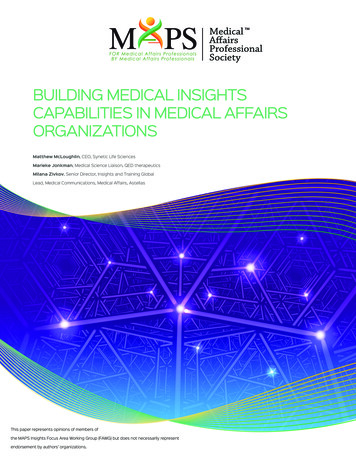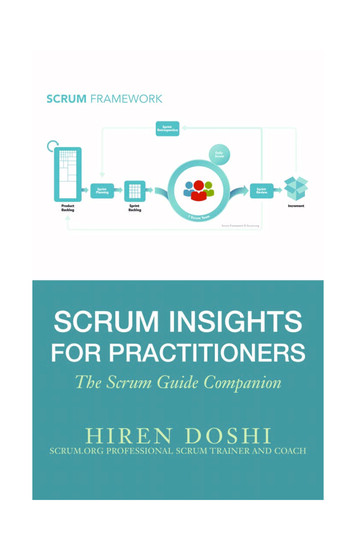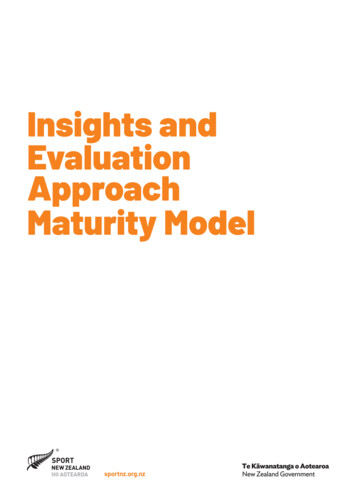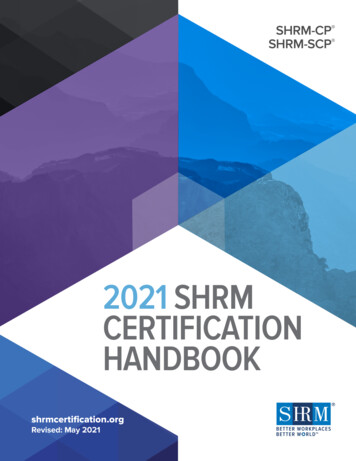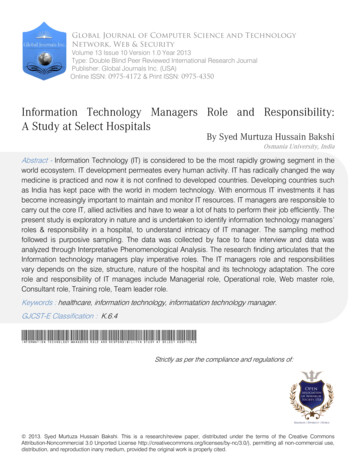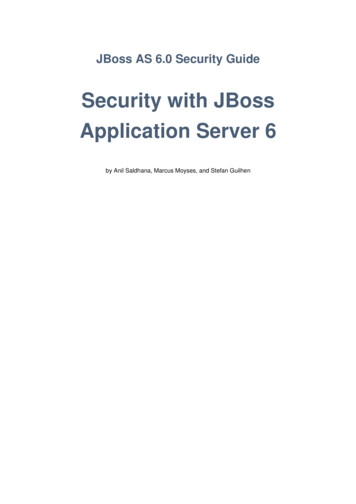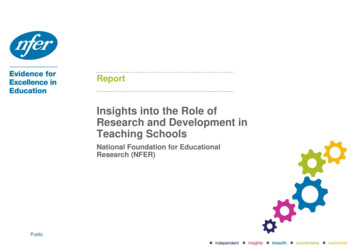
Transcription
ReportInsights into the Role ofResearch and Development inTeaching SchoolsNational Foundation for EducationalResearch (NFER)Public
Insights into the Role of Research and Development inTeaching SchoolsMatt WalkerPublished in January 2017By the National Foundation for Educational Research,The Mere, Upton Park, Slough, Berkshire SL1 2DQwww.nfer.ac.uk 2017 National Foundation for Educational ResearchRegistered Charity No. 313392ISBN: 978-1-911039-25-9How to cite this publication:Walker, M. (2017). Insights into the Role of Research and Development in Teaching Schools. Slough: NFER.Public
Contents1Introduction12At a glance13Background24Findings from NFER survey of teaching schools and a comparison group of schools55Discussion116Methodology137References15
1IntroductionEvidence-informed practice is now regarded as instrumental toschool reform efforts both in England and elsewhere (Greany,2015). This is especially important given the focus on school selfimprovement coupled with a drive for high-quality teaching within adevolved, and increasingly autonomous, education system.Teaching schools are outstanding schools that work with strategicpartners, such as universities and private sector organisations, toprovide high-quality training and development to new and toexperienced school staff. Research and development or ‘R&D’forms one of their six key areas of responsibility, often referred to asthe ‘big six’. As such, teaching schools play an important role inhelping to realise the government’s aim of increasing teachers’access to and use of high quality evidence and in ensuring teachersare trained in understanding and applying evidence (DfE, 2016).This report seeks to explore the effectiveness with which teachingschools are delivering their R&D responsibilities. It provides newinsights based on an analysis of a survey of teaching schools and acomparison group of outstanding schools. In doing so, our aim is tosupport the sector as a whole by reviewing the activities undertakenby teaching schools and their alliances in support of R&D, and thechallenges they face in implementing them. It is hoped that thefindings will contribute to the wider evidence base on the extent towhich teaching is becoming a more evidence-informed profession.2At a glanceThere is evidence to suggest that R&D is becoming increasinglyembedded within the other areas of the big six, and particularlywithin school-led initial teacher training (ITT) and continuingprofessional development (CPD).Despite this, many teaching school alliances (TSAs) report thatR&D is treated as an ‘add-on’ and is considered less importantcompared to other concerns.Many TSAs report engaging ‘to a great extent’ in producingevidence-informed outputs and yet do not appear to prioritise thedevelopment of their staff’s research literacy to the same degree.There are many challenges facing TSAs in delivering R&D includingthe long time it can take to show the impact of R&D and the factthere is still a need to build an expectation for teaching as anevidence-based profession.Respondents report that research organisations like NFER can helpto overcome some of the challenges identified. This includes thesuggestion that research organisations can do more to make thefindings from research evidence more accessible to practitioners.There is some evidence to suggest that teaching school status doesnot necessarily enhance a teaching school’s level of researchactivity, relative to other outstanding schools.Insights into the Role of Research and Development in Teaching Schools 1
3BackgroundEvidence-informed practice is instrumentalto school reformThe debate about the need for an evidence-informed teachingprofession has recently been reinvigorated following thegovernment’s White Paper, Educational Excellence Everywhere(DFE, 2016). The paper emphasises the importance of building astrong, evidence-informed profession to help drive up standards inschools. Indeed, it is clear that evidence-informed practice is nowregarded as instrumental to school reform efforts in England andelsewhere (Greany, 2015). This is especially pertinent with so muchfocus on school self-improvement coupled with a drive for highquality teaching within a devolved, and increasingly autonomous,education system.Teaching schools have an important roleto play in helping to spread evidenceinformed practiceTeaching schools are outstanding schools that work with strategicpartners, such as universities and private sector organisations, toprovide high-quality training and development to new and toexperienced school staff. They are part of the government’s plan togive schools a central role in raising standards by developing a selfimproving and sustainable school-led system (NCTL 2016).Teaching school alliances (TSAs) are groups of schools, led by ateaching school, and include strategic partners who lead someaspects of training and development.Research and development, or R&D, forms one of teachingschools’ six core areas of responsibility. The others are: school-ledinitial teacher training; continuing professional development;supporting other schools; identifying and developing leadershippotential; and recruiting and managing the placements of specialistleaders of education. Collectively, these are often referred to as ‘thebig six’. In order to meet their R&D responsibility, teaching schoolsare expected to engage in a range of activities, as detailed below.Box 1: Activities teaching schools are expected to undertake insupport of R&DAs such, teaching schools play an important role in helping to buildexisting researchcontribute toalliance andwiderrealisetheongovernment’saim andof increasingteachers’accessto andprioritiesuse of high quality evidence and ensuring teachers are trained in2. on existing evidence andunderstandingand applying base new initiativeswithinevidencetheir allianceensure they can measure them work with other teaching schools in their area, or nationally, whereappropriate ensure that their staff use existing evidence allow their staff the time and support they need take part in R&Dactivities share learning from research and development work with the widerschool systemInsights into the Role of Research and Development in Teaching Schools 2
The number of teaching schools has beengrowing and there are plans for moreIn November 2010, the Schools White Paper, The Importance ofTeaching (DfE, 2010), set out the UK Government’s plan toestablish a national network of teaching schools as part of thepolicy aim of developing a self-improving school system. Sincethen, their numbers have grown considerably. To date, there havenine cohorts of teaching schools. Figures from the National Collegefor Teaching and Leadership (NCTL) show that in July 2016 therewere 765 teaching schools and 596 TSAs (NCTL, 2016). As ofOctober 2014, at least 7,144 schools were linked with the teachingschools initiative, representing 32 per cent of all maintained schoolsin England (Gu et al. 2015). Not all alliance schools will beoutstanding. Alliances can be set up in three different ways. Theyare: single alliance (one teaching school leading one TSA; jobshare alliance (two small or special schools jointly leading oneTSA); and multiple alliance (two or more teaching schools leadingone alliance.Teaching school status is open to all schools in England regardlessof type or phase. In terms of raw numbers, the majority are primaryschools, followed by secondary schools and special schools.The government’s White Paper, Educational ExcellenceEverywhere, signalled the Government’s intention to expand theexisting teaching school network by creating 300 more (DfE, 2016).The evidence on the effectiveness withwhich teaching schools deliver theirresearch and development responsibilitiesis limitedA two-year research project led by the University of Nottingham andcommissioned by the NCTL provides the most robust qualitativeand quantitative evidence to date on the effectiveness and impactof teaching schools (Gu et al, 2015).The evaluation used a mixed methods approach comprising indepth case studies and a survey of teaching schools across cohortsone to three. The evaluation also drew on statistical data to look atprogramme reach and association with pupil performance.Most of the insights gathered around teaching schools’ R&D workappear to be drawn from the case studies. Here, the authors foundsomething of a mixed picture. While some alliances had beenproactively promoting R&D in their schools, others (both primary-ledand secondary-led) were reported to have not yet developed theirR&D work.There was evidence that most TSAs were getting support to helpdeliver R&D, with the majority of TSAs working with HEI partners.The evaluation also highlighted a number of challenges to TSAs’R&D work. These included: securing the time and involvement from other schools (includingthe active involvement of class teachers) accessing academic journals and papersInsights into the Role of Research and Development in Teaching Schools 3
accessing materials about what other teaching schools aredoing and getting involved in national R&D activity senior leaders in some schools finding it difficult to engage withthe R&D agenda.The authors concluded that achieving a school-wide and alliancewide understanding of research in a school context was still to bedeveloped in the majority of case study alliances.Insights into the Role of Research and Development in Teaching Schools 4
4Findings from NFER survey ofteaching schools and acomparison group of schoolsThe findings in this report are based on an analysis of surveyresponses from teachers in a sample of teaching schools and acomparison group of Ofsted-category outstanding schools. Thesurvey was undertaken using computer assisted telephoneinterviewing (CATI) in March 2016. It was completed by the personresponsible for coordinating research activity across the school oralliance, or a person who could speak on this issue. Responseswere achieved from staff in a total of 83 teaching schools and 80other outstanding schools. There are limitations to the precision ofthe findings due to the relatively small size of the achieved samples.Further details are provided in Section 6. Nevertheless, theachieved samples are broadly representative of the nationalpopulations of teaching schools and other schools rated asoutstanding by Ofsted, and as such, the findings provide someuseful insights into the effectiveness with which teaching schoolsare delivering their R&D responsibilities.There is evidence to suggest that R&D isbecoming increasingly embedded withinthe other areas of the Big Six, andparticularly within ITT and CPDOne of the unique things about R&D, relative to TSAs’ otherpriorities, is that it can underpin the other areas of the Big Six. Thefindings shown in Figure A suggest that R&D is most heavilyembedded within school-led initial teacher training (ITT) andcontinuing professional development (CPD).Figure A: R&D is most heavily embedded within ITT and CPDQuestion: 'I’m going to read out the other five core areas of responsibility which, in addition toR&D, make up the ‘Big Six’. Please say whether R&D is fully embedded, partially embedded,used sporadically, or not embedded at all in each area of responsibility’.Source: NFER survey of teaching schools, 2016 (n 83)Insights into the Role of Research and Development in Teaching Schools 5
More than 80 per cent of respondents reported R&D was ‘fully’ or‘partially embedded’ within CPD and school-led ITT. R&D wasreported to be less well embedded within each of the other coreareas, with about two in ten teaching schools reporting it was ‘not atall embedded’ within the area of ‘specialist leaders of education’.Previous research commissioned by the National College andundertaken by a group of TSAs in February 2015 asked a similarquestion of staff working in TSAs and achieved 178 responses(Bamfield, 2015). Compared with the National College findings, theNFER findings show a greater proportion of respondents reportingthat R&D is ‘fully’ or ‘partially embedded’. Thus, there is someevidence to suggest that R&D has become increasingly embeddedwithin the other areas of the Big Six over the intervening 12 months.teaching schools are developing their staff’s research skills andabout the resulting quality and impact of this work.We asked respondents in both teaching schools and ourcomparison group of outstanding schools a closed question aboutthe extent to which they engaged in a range of different activities insupport of their R&D work. Selected findings for teaching schoolsare presented in Figure B. The findings for comparison schools arediscussed in Section 5.Figure B: TSAs most frequently encourage staff to engage inenquiry and produce research-based materialsMany TSAs report engaging ‘to a greatextent’ in producing evidence-informedoutputs and yet do not appear to prioritisethe development of their staff’s researchliteracy to the same degreeAs outlined in the White Paper, Educational ExcellenceEverywhere, the government seeks to build a high quality teachingprofession which embraces evidence-based practice to drive upstandards in schools DfE, 2016. Yet in order for this to happen,teachers need the research skills to evaluate and challengeresearch findings, in addition to knowing where and how to accessrelevant research, and how this can be applied to classroompractice. Our findings raise questions about the extent to whichQuestion: 'I’m going to read out six things that your TSA may or may not do. For each one,please say whether your TSA does it to a great extent, to some extent, very little, not at all, oryou don’t know'Source: NFER survey of teaching schools, 2016 (n 83)Insights into the Role of Research and Development in Teaching Schools 6
While 37 per cent of respondents reported that they ‘produceadvice, tools and interventions that are informed by research’ ‘to agreat extent’ (option b), only ten percent reported that their TSAwas engaged to the same degree in developing their staff’s ‘abilityto understand and critique research as part of their alliance’sprofessional development strategy’ (option f). Previous researchhas found that collaborative R&D across alliances requires a rangeof practitioner research skills and that a lack of research capacityand skills are significant barriers to sustainability (Stoll, 2015).However, this is not to say that TSAs are not developing their staff.Indeed, when combining the responses from those that reported ‘toa great extent’ with ‘to some extent’, 75 per cent of respondentsreported that they developed their staff’s ability to understand andcritique research, compared to 91 per cent that reported producingoutputs that are informed by research. Nevertheless, the findingssuggest that if the quality of their research-informed outputs is to bemaintained, some TSAs might consider placing a greater emphasison developing their staff’s research skills.Many TSAs report treating R&D as an ‘addon’ and consider it less importantcompared to other concernsadd-on, rather than as a key part of the alliance’s efforts toraise standards’. Half of TSAs have not yet fully prioritised their R&D work.52 per cent of respondents ‘agreed’ or ‘strongly agreed’ withthe statement: ‘We have not yet fully prioritised our R&D workand need to develop it further’. For many, R&D is a low priority relative to other concerns.Of those answering an open question, 30 per cent ofrespondents reported the main challenge facing their TSA indelivering R&D was that it was a low priority relative to otherconcerns. Not all alliance schools have staff with designatedresponsibility for R&D. Most TSAs (59 per cent) reported onlyhaving designated R&D leads in ‘some’ of their allianceschools, while more than a quarter (28 per cent) have nodesignated R&D leads in any of their alliance schools.The findings raise questions about the extent to which someteaching schools are effectively spreading and promoting the use ofresearch evidence across their alliance and the wider educationsystem. The findings broadly support those of the two-year NCTLstudy. They suggest that many TSAs approach their R&Dresponsibilities in different ways, and often give it a low priorityrelative to other concerns.The survey findings revealed multiple indicators of this, for example: About half of TSAs reported R&D was viewed as an ‘addon’. 54 per cent of respondents ‘agreed’ or ‘strongly agreed’with the statement: ‘R&D is viewed by many colleagues as anInsights into the Role of Research and Development in Teaching Schools 7
Most TSAs appear to focus on ‘engaging in’research as distinct from ‘engaging with’researchTwo main forms of research engagement are distinguished instudies of the subject: responding to public research (‘engagementwith’) and doing one’s own research (‘engagement in’). For thepurposes of the survey, we described the first activity (engaging‘with research’) as ‘how you access, understand and applyacademic or professionally produced research across yourschool/TSA’. The second activity was described as ‘enquiry’, anddefined as ‘practitioner-led research or action research’.Figure B shows that while 37 per cent of respondents reportedencouraging their staff to engage in enquiry ‘to a great extent’, only27 per cent reported encouraging their staff to engage ‘withresearch’ to the same degree. In practice, NFER has found thatmany research-engaged schools undertake both activities, and thatboth can have an appropriate place in supporting evidenceinformed practice (Judkins et al, 2014). However, the findings couldsuggest that TSAs view enquiry-based activities as beingparticularly important, and/or that they need support to build thecapacity of teachers to meaningfully engage with academic orprofessionally produced research evidence.There are a range of challenges facingTSAs in delivering R&DWe explored the challenges facing TSAs in delivering R&D throughtwo questions: the first an open question; the second a series ofsingle response items.In response to the open question, ‘Other than funding and a lack oftime, what would you say is the main challenge facing your alliancein delivering R&D?’, three in ten respondents (30 percent) reportedthe main challenge facing their TSA in delivering R&D was that itwas a low priority relative to other concerns. This was followed bydifficulties in accessing research evidence (11 per cent), and thelack of confidence that some teachers felt in making use ofresearch evidence (10 per cent).While there is nothing particularly new about these findings, they dosupport arguments that NFER (Durbin and Nelson, 2014) andothers have been making for a number of years about the factorspreventing schools from accessing or using research evidence.Namely, that there is still work to be done in: creating a demand for evidence in schools (particularly for usingacademic or professionally produced research evidence) improving the supply and accessibility of research evidence building the capacity of teachers to meaningfully engage withresearch evidence.In addition to the open question, respondents’ answers to a seriesof single response questions revealed a number of additionalchallenges to delivering their R&D work (see Figure C).Insights into the Role of Research and Development in Teaching Schools 8
Chief amongst these was the speed required when carrying outR&D in order to demonstrate its impact, with almost three quarters(72 per cent) reporting they ‘strongly agreed’ or ‘agreed’ that thismitigated against quality R&D which can take time to undertake andembed. This was also identified as a major challenge in the twoyear National College evaluation of teaching schools (Gu et al,2015). Our findings appear to confirm those reported in the NationalCollege study, while also suggesting that this continues to be achallenge.Figure C: TSAs reported they face a number of challenges indelivering R&DJust over half (56 per cent) ‘strongly agreed’ or ‘agreed’ that theywere having to spend a lot of time building an expectation andenthusiasm for teaching as an evidence-based profession. Asreported earlier, a similar proportion (54 per cent) reported thatR&D was viewed by many staff as an add-on, rather than as a keypart of the alliance’s efforts to raise standards.While for some, these challenges may have stemmed fromrespondents’ views that their TSAs have not yet fully prioritisedR&D and needed to develop it further (52 per cent: see Figure C,option D), a notable minority rejected this view (34 per cent‘disagreed’ or ‘strongly disagreed’).We also asked a similar question of respondents from our sampleof Ofsted-category outstanding schools. They appeared to broadlyrecognise the same challenges to delivering R&D as theircounterparts in teaching schools, albeit to a more limited degree. Anotable difference was that a smaller proportion of respondents inour comparison sample (compared to those in teaching schools)‘strongly agreed’ or ‘agreed’ that:Question: I’m going to read out five things that may or may not represent challenges to yourR&D work. For each one, please say whether you strongly agree, agree, neither agree nordisagree, disagree or strongly disagree that it represents a challenge to your R&D work. If youdon’t know the answer, please feel free to say so.’Source: NFER survey of teaching schools, 2016 (n 83)Figures may not sum to 100 due to rounding. they were having to spend a lot of time building an expectationand enthusiasm for teaching as an evidence-based profession(42 per cent compared to 56 per cent) R&D was viewed by many staff as an add-on (46 per centcompared to 54 per cent).It is unclear whether these responses reflect the fact thatcomparison schools have been more successful than teachingschools, and/or their alliances, in overcoming these challenges.Insights into the Role of Research and Development in Teaching Schools 9
Teachers identified a number of actionsthat research organisations can take tohelp support them to deliver R&DIn response to an open question, respondents identified a numberof activities that research organisations, like NFER, could undertaketo best support TSAs, and other schools, in a self-improving schoolsystem.Chief amongst these was the need for research evidence to bemade more accessible to practitioners (as reported by 38 per centof respondents from our teaching school sample and 48 per cent ofrespondents from our comparison school sample). This wasfollowed by support to help interpret and use research evidence (asreported by 26 per cent of respondents from our teaching schoolsample and 10 per cent of respondents from our comparison schoolsample). Several of the comments from respondents in thecomparison school sample suggested this could be best deliveredby researchers working alongside schools.The findings suggest that there is more that the researchcommunity can do to help address some of the structuralchallenges, reported earlier, that are facing schools in deliveringR&D.Insights into the Role of Research and Development in Teaching Schools 10
5DiscussionThere is evidence to suggest that teaching school status does notnecessarily enhance an individual teaching school’s level ofresearch activity, as measured by selected R&D indicators, relativeto other Ofsted-category outstanding schools.likely to report doing ‘very little’ or nothing (‘not at all’) for theseactivities, than those in the teaching school sample. The relativelysmall sample sizes, particularly for the comparison group ofschools, should also be taken into consideration when consideringthese findings.Figure D: TSAs most frequently encourage staff to engage inenquiry and produce research-based materialsWe asked respondents both from teaching schools and from ourcomparison sample of outstanding schools to what extent they wereengaged in a range of activities in support of R&D. For all but oneactivity, a greater proportion of staff in outstanding schools reportedthey were doing these things ‘to a great extent’ than those inteaching schools, as shown in Figure D. While not statisticallysignificant, there are particularly notable differences between thetwo samples in the proportion reporting that their TSA (or school inthe case of respondents in the comparison sample) does thefollowing ‘to a great extent’: ‘build capacity to spread evidence-based practice’ (51 per centin comparison schools compared to 35 per cent in teachingschools) ‘produce high-quality practical advice, tools and interventionsthat are informed by research’ (48 per cent in comparisonschools compared to 37 per cent in teaching schools).It should be pointed out that when we combine the proportionreporting ‘to a great extent’ with ‘to some extent’, the differencebetween the two samples narrows. It is also the case that staff fromour comparison sample of outstanding schools were generally moreQuestion: ' I’m going to read out six things that your TSA [wording used for teaching schoolssample]/school [wording used for comparison schools sample] may or may not do. For eachone, please say whether your TSA/school does it to a great extent, to some extent, very little,not at all, or you don’t know'.Source: NFER survey of teaching schools (n 83) and Ofsted-category outstanding schools(n 80), 2016Insights into the Role of Research and Development in Teaching Schools 11
Nevertheless, the findings do cause pause for thought. On the faceof it, it might seem counterintuitive that staff in teaching schools,which have a specific responsibility for delivering R&D, would reportbeing engaged in these activities on behalf of their alliance lessintensively than staff in other outstanding schools. One possibleexplanation is that R&D activity is being squeezed becauseteaching schools are occupied with their other responsibilities andparticularly with delivering school-led ITT and CPD. By contrast,other outstanding schools are free to focus on other things,including R&D. Extending this thinking further, one might speculatethat six areas of responsibility is too many, and that teachingschools would be better able to dispense their responsibilities if thenumber of their priorities was reduced.But the findings also give rise to cautious optimism, as they suggestthat other outstanding schools are engaged in activities that supportR&D, and that they are choosing to do this, even without anyexplicit requirement for them to do so.A new addition to the schools landscape is the Research SchoolsProject, which is a partnership between the Education EndowmentFoundation (EEF) and the Institute for Effective Education (IEE) atthe University of York. Together, they are funding a network ofschools that will support the use of evidence to improve teachingpractice. The intention is that Research Schools will become afocal-point for evidence-based practice in their region, buildingaffiliations with large numbers of schools and supporting the use ofevidence at scale. It is expected that Research Schools will engagewith local schools in a variety of ways and with varying degrees ofintensity.Following a competitive application process, the first five ResearchSchools have been appointed, with a further five to join in 2017.Each of the ten schools will receive 200,000 over three years toenable them to fulfil their roles 1. Of the first five schools, four arealso teaching schools. Given the findings and discussion presentedabove, it will be interesting to see how their focus on evidencebased practice will be managed alongside their otherresponsibilities.This report has looked at the extent of activity undertaken byteaching schools and their alliances in support of R&D, and thechallenges they face in implementing them. While there are now arange of evidence-based resources and tools available to helpimprove teaching practice and raise the attainment of pupils, gettingresearch into schools in ways that really make a difference in theclassroom remains a challenge for many. In a self-improvingschool-led system, teaching schools continue to play an importantrole in leading and supporting evidence-informed practice. Theirefforts should be supported, by research organisations, policymakers and the wider education community, as without effectiveschool-led support there is a danger that evidence-informedpractice in schools could be, and in some places will continue to be,dispersed and piecemeal.1By comparison, cohort ten teaching schools will receive ‘core funding’totalling 190k over four years to deliver their six areas of responsibility.Insights into the Role of Research and Development in Teaching Schools 12
6MethodologyDataThe findings in this report are based on an analysis of surveyresponses from teachers in a sample of teaching schools and acomparison group of Ofsted-category outstanding schools. Thesurvey was undertaken using computer assisted telephoneinterviewing (CATI) in March 2016. CATI offers a number ofadvantages over paper and/or online surveys, including: high quality of collected data: the telephone interviewer canensure that questions are fully understood and are notmisinterpreted by the intervieweemore complete data: the telephone interviewer can ensure thatall questions are answeredtime reduction: the whole process is speeded up because datais entered as it is obtained (compared with paper surveys).The survey was completed by the person responsible forcoordinating research activity across the school or alliance, or aperson who could speak on this issue. Responses were achievedfrom staff in a total of 83 teaching schools and 80 outstandingschools.Response ratesTeachingschoolsComparisonschoolsNumber ofschoolscontacted464Number ofschoolsachieved83Response rate6888012 %18 %DefinitionsKey terms used within the survey were described to interviewees asfollows: R&D “activities that support research engagement, such ashow you access, understand and apply aca
nine cohorts of teaching schools. Figures from the National College for Teaching and Leadership(NCTL) show that in July 2016 there were 765 teaching schools and 596 TSAs (NCTL, 2016). As of October 2014, at least 7,144 schools were linked with the teaching schools initiative, representing 32 per cent of all maintained schools in England (Gu et al.



